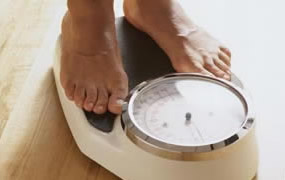Healthy Weight Overview
What is a healthy weight?

A healthy weight is the weight your body naturally settles into when you consistently eat a nutritious diet, are physically active, and balance the calories you eat with the physical activity you do. Reaching a specific weight is not as important as the lifestyle changes you make to become healthy.
Why is healthy weight important?
Being at a healthy weight can reduce your risk of weight-related diseases, such as coronary artery disease, sleep apnea, type 2 diabetes, high blood pressure, and stroke. But weight is only one part of health. Even if you carry some extra weight, by eating healthfully and getting plenty of physical activity, you will feel better and have more energy. In fact, you may be healthier than a thin person who eats poorly and isn't physically active.
Why is losing weight so hard?
Although a weight-loss diet may help you lose a few pounds quickly, following a restrictive diet long-term is unrealistic and requires extraordinary commitment. Once you stop dieting and exercising, the weight comes back. Some people fall into an unhealthy cycle of losing and gaining weight, which may be harder on the body than just being overweight.
It may be difficult to overcome the roadblocks to weight loss: lack of time for exercise, family and work commitments, easy access to less-healthy foods, and illness or injury.
Research shows that people who are most successful in improving their health have made the broader and more significant shift to a healthier lifestyle rather than targeting weight loss alone. A lifestyle of healthy eating and regular physical activity will improve your health and quality of life, no matter what you weigh.
How do I change my lifestyle?
First you'll need to learn the skills to make lifelong changes and find the support you need to create a healthy lifestyle that's right for you. Look for balanced, realistic, and enjoyable ways to fit healthful changes into your life.
Making small changes, such as being aware of your portion sizes, eating more fruits and vegetables, and adding more physical activity to your daily routine, can add up to significant improvements in your health.
Walking is an activity that most people can do safely and routinely with family members, friends, coworkers, or pets. Keep track of the number of steps you take with a step counter or pedometer, which you can buy at a sporting goods store. If you have a desk job, you'll see how little you actually move in a typical day. Wearing the step counter may motivate you to accumulate more steps during the day.
To be successful in making lifestyle changes:
Don't diet. Abandon the idea that you'll go on a diet and quickly lose a certain amount of weight. This approach almost always fails. Instead, try to make healthy eating choices that work for you.
Think about your relationship with food. Do you eat when you are bored, stressed, or sad? Do you use food as a reward? Try making a list of other ways you can comfort or reward yourself that don't involve food.
Slowly change your eating habits. If you are ready to improve your nutrition, you may be tempted to do a diet overhaul and change everything about the way you eat. But you will be more successful at staying with the changes you make if you pick just one eating habit at a time to work on.
Establish goals you can reach. Set small goals. Your goals should be specific, within your reach, and flexible. A goal to simply exercise more is too general. Instead, make a specific plan to be active for a certain amount of time each week. For example, start with a goal to walk for 15 minutes 3 times a week, and then slowly increase it to 20 minutes 4 times a week. When you reach this goal and it has become routine, set a new one. But realize you may have setbacks now and then; it doesn't mean you've failed.
Make daily physical activity a part of your routine. Identify what keeps you from being active or exercising. Are you juggling a demanding job with raising kids? Maybe you can start a walking group at work during lunchtime. Arrange for someone else to pick up the kids from day care or soccer practice 1 day a week so you can make time for physical activity. Or pick an activity that your family can do together, such as taking a bike ride or playing Frisbee.
How can I fit physical activity into my busy day?
Try to make physical activity a regular and essential part of your day, just like brushing your teeth or going to work. Start slowly and be sure to consult your doctor first if you aren't active at all. Consider scheduling your activity in the morning if you tend to talk yourself out of it later in the day.Take the stairs instead of the elevator. Park far away and walk to your office or the grocery store. Make a plan to ride your bike to work once a week. Instead of e-mailing a coworker, get up and walk to his or her desk. If you don't have time to take one 30-minute walk, break it up into three 10-minute walks.
If you want a more structured way to get exercise, consider joining a health club or community center that offers fitness activities. Find an activity that you enjoy and feel you can stick with, and then vary it with other activities so you don't get bored. For example, 3 days a week, take a brisk 30-minute walk with a friend and then lift some weights together. On other days, take a water aerobics class, ride a bike, or take the dog for a hike. Join a softball, volleyball, or basketball league. The more you can find activities you like, the greater your chances for success.
